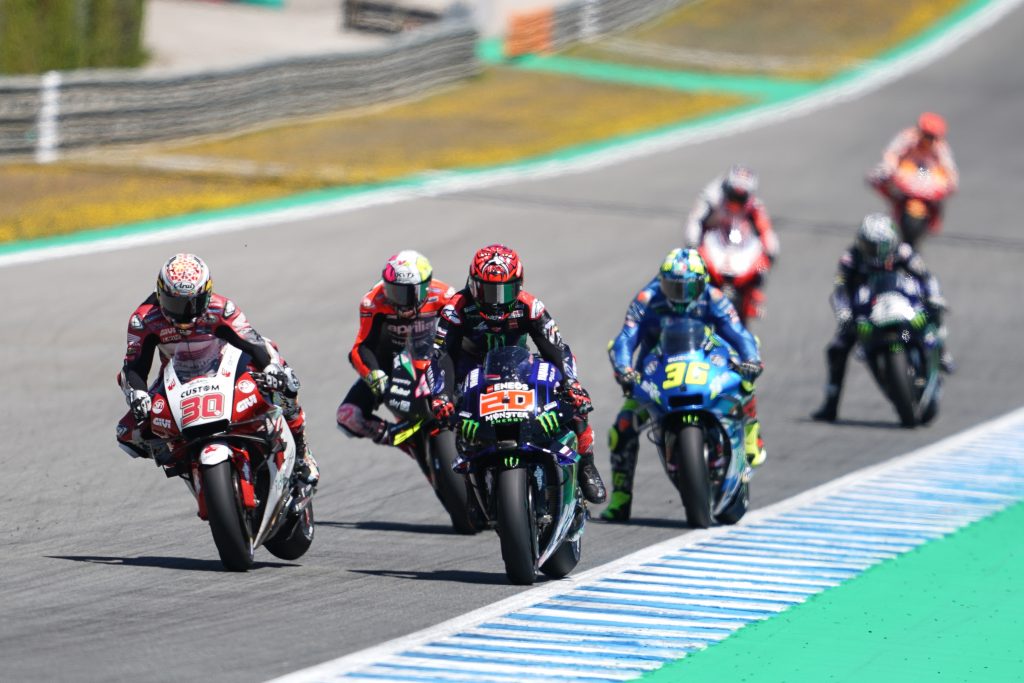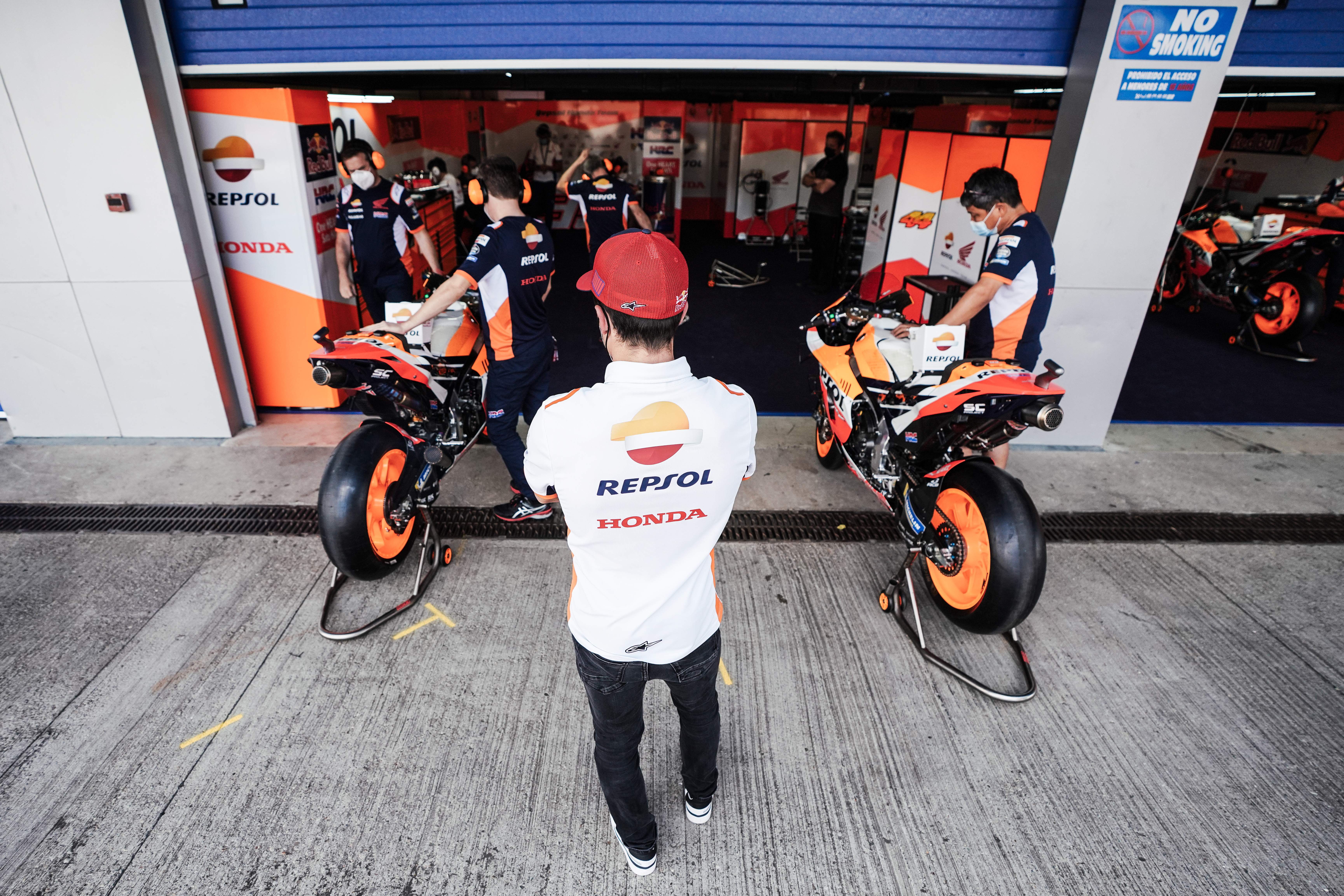When Marc Márquez returned to the MotoGP grid for the first time in eight months, he came back to a very different bike. Despite the engine development freeze put in place because of Covid-19, there had been a lot of changes to his Honda RC213V. The engine was the same but the frame and chassis had altered, needing a different setup for Márquez to get his head around.
An even bigger change were the holeshot devices which have been added front and rear. “I never used it, and today they explained to me the front device, the rear device, and because everybody is using it, it’s something that I need to use to ride and for the start it will be important,” the Spaniard told the press conference on Thursday afternoon before the race. All of a sudden, Márquez had extra levers to push in the right order upon arriving on the grid.
The six-time MotoGP champion was not a fan. “For me, honestly speaking, it doesn’t make sense to have a holeshot device on a bike. Two years ago, we didn’t have a holeshot device, even on the straight, and the show was the same on the TV. It’s an extra thing that doesn’t improve the show, and will be even more difficult to overtake.”

As it happened, there was plenty of overtaking on Sunday, and plenty of show. And Marc Márquez is really far too young to be complaining of technological novelties. Even when, like holeshot devices, they are very far from being new fangled.

Holeshot devices have been around for a long time. They started in motocross, with a system for locking down the front forks at the start. When I asked the expert – namely, the esteemed editor of this publication – Adam Wheeler told me they became common at the start of the century, though there are rumours of them being used as far back as the 1970s. The device for lowering the rear and compressing the shock was first used sometime around 2013 in MXGP. They are no novelty in road racing either. Honda was using them in BSB around a decade ago, while Gresini Honda tested a system around 2012.
So ubiquitous have holeshot devices become that they are now available at MX specialists around the world. For a couple of hundred pounds, you can have a device fitted both front and rear.
If they are so old, why the interest in MotoGP all of a sudden? Two reasons: firstly, the switch to spec electronics took away the weapons the factory engineers were using to control the bikes. No longer could factories throw resources into their custom ECU software, and devise ever more sophisticated anti-wheelie and launch strategies. That cut costs enormously, and it also made the racing much, much closer. And with racing so tight in MotoGP – the Doha MotoGP race was the closest top 15 in Grand Prix history – details become ever more important. When tenths of a second aren’t available, then hundredths really begin to matter.

The aim of the holeshot devices is to get into the first corner ahead of the pack. They achieve that by turning the bike into a dragster, either by locking the front forks down (Suzuki), locking the rear shock down (Yamaha), or preferably both (Aprilia, Ducati, Honda, KTM). Lowering the centre of gravity like that reduces wheelie, creates more mechanical grip, and that translates into better acceleration.
The peculiar circumstances of MotoGP compared to MXGP opened up new avenues. Beyond the budgets (a massive factor, admittedly), MotoGP bikes have to complete a lap before arriving to the grid. This means that riders, not mechanics, have to engage the holeshot devices. This means riders have to have levers and switches (butterfly or otherwise) at their disposal so they can actually lower the bike for the start.
And if you have the lever close enough to hand, why not use it during the race? If lowering the rear of the bike improves acceleration at the start, then why wouldn’t it help on the exit of corners as well? Especially corners which lead on to long, fast straights.

Which is pretty much what Ducati did. After debuting their rear lowering device in 2018, by 2019, they had revised it so that it could be used during the race on corner exit. That was not always easy to deal with while hanging off the bike at 160 km/h. And so the rules, bolstered by paddock rumour, suggest that this has been taken out of the riders hands.
Since early this year, the rules include a paragraph which allows the use of ride height systems which operate based on bike pitch and load, without the intervention of the rider. Active control systems (e.g. via electronics) are still banned. But passive systems, operated by the movement of the bike, are allowed.

Is this a technology that has no bearing on the real world of motorcycling outside of a race track? The proliferation of electronic suspension systems suggests the opposite. Understanding the interaction between bike pitch and suspension behaviour is a crucial part of vehicle dynamics. You can learn that from passive systems in MotoGP, and refine it in electronic systems on road bikes. Ducati has its Skyhook system, BMW Dynamic ESA, and now, even Harley Davidson has an Adaptive Ride Height system on its brand new Pan America adventure bike.
Marc Márquez acknowledged his resistance was a lost cause. “Now everybody is using it so, of course, we will use it,” he said on Thursday. And by Sunday, he had accepted his lot. “The start was really good,” he said after the race. “It was my first with this holeshot device.” It won’t be his last. Whether he likes it or not.
By David Emmett @motomatters
Photos by CormacGP @cormacgp








